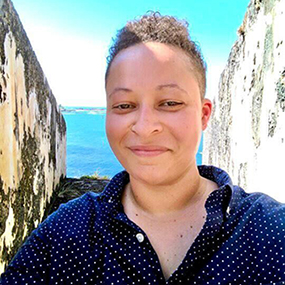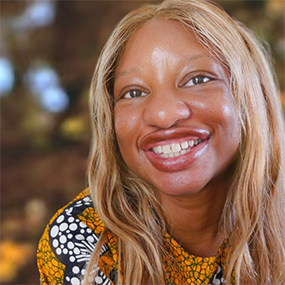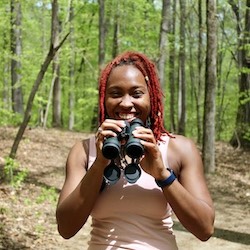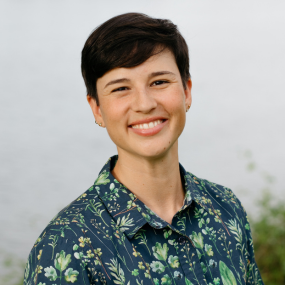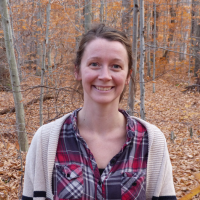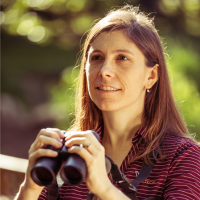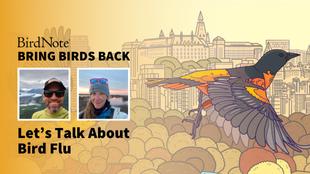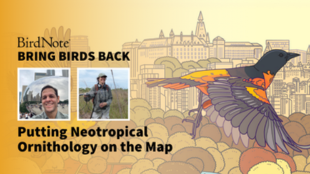

Join BirdNote tomorrow, November 30th!
Illustrator David Sibley and actor H. Jon Benjamin will face off in the bird illustration battle of the century during BirdNote's Year-end Celebration and Auction!
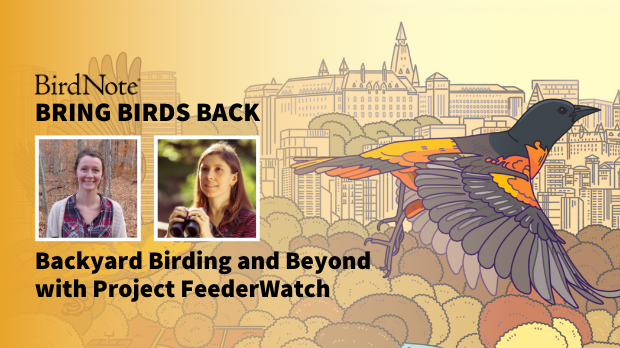
Since 1976, Project FeederWatch has been through many changes and iterations. But what has remained is the dedication to collecting data that undeniably improves bird science. In this episode, host Deja Perkins speaks with Emma Greig, the U.S. Project Leader for FeederWatch, about what this data has uncovered over the years. Deja also speaks with wildlife researcher Ashley Dayer, and gets into the specifics about all the great things bird feeding does for you – and despite some criticisms, great things it does for the birds, too!
Want more Bring Birds Back? Subscribe to our show and follow us on Instagram! For more about BirdNote, sign up for our weekly newsletter. And for ad-free listening and other perks, sign up for BirdNote+ here.
BirdNote is a nonprofit. Your tax-deductible gift makes these shows possible.
Bring Birds Back Season 6 is sponsored by the Cornell Lab of Ornithology and the American Bird Conservancy.
Deja Perkins:BirdNote Presents.
[Bring Birds Back Stinger]
Deja Perkins: From BirdNote, this is Bring Birds Back. I’m Deja Perkins.
Birding can be done in so many ways– and watching bird feeders is one of the most accessible activities of them all. It’s one way to bring nature closer to you, and for many people, it’s also their first introduction to the world of birds. This is how I got my own start in birding; at the window feeders at Minnesota Valley National Wildlife Refuge. As a visitor services intern, I found the birds at the feeders to be an easy and reliable way to engage visitors.
And as a newbie myself, the bird feeders allowed me to see and learn about the different patterns and identification markers of different species. Plus, it was a really fun way to learn about bird behavior. Seeing smaller birds like Red-Winged Blackbirds, White-Breasted Nuthatches, and Downy Woodpeckers suddenly scatter when a juvenile Cooper’s Hawk landed atop the feeder was thrilling; Other times, they’d scatter only for a Blue Jay to swoop in and hog all the food. Who knew that some birds ate other birds– or had the ability to mimic another?!
Bird feeders not only provide an accessible personal learning opportunity, but collectively, they also help researchers learn about birds and their impact on people. This is also true for Project FeederWatch, one of the longest running bird feeding programs in North America. Project FeederWatch is a participatory science program that runs annually from November through April across the US and Canada.
Participants count the birds that come into their yard and report those observations to researchers at the Cornell Lab of Ornithology and Birds Canada. Those researchers keep track of participant observations and analyze the data to help us have a better understanding of birds– and the world around them. A simple, but important practice that has contributed to decades of scientific discovery.
Later in this episode, we’ll hear from Dr. Ashley Dayer, a conservation social scientist, about the new and exciting insights they’ve gained from Project Feederwatch about people and birds, thanks to bird feeding.
But first up, let’s learn all about Project FeederWatch, its history, impact and purpose from the project’s US lead, Emma Greig.
Deja Perkins: Hi, Emma. Welcome to the show. Thank you so much for being here. Can you give us a little bit of an origin story? Why was Project FeederWatch started and how long has it been in existence?
Emma Greig: Yeah, well… It was conceived by a woman up in Canada named Erica Dunn, who, um, thought, gosh, I wish there was a good way to keep track of winter birds, and also thought, gosh, so many people like to feed birds.
They just do this anyway, and they're watching the birds out their window. So what if we just asked people to take some notes about the birds that they're already looking at and paying attention to. And so that was how the whole thing got started so long ago with probably just a few hundred participants to begin with.
Deja Perkins: That annual observation was named the Ontario Bird Feeder Survey and its first year on record goes back to 1976. Back then, it was conducted at the Long Point Bird Observatory in Canada, but over the next decade, the survey garnered over 500 contributors and continued to scale up, stretching across the United States.
Today, Project FeederWatch is a joint endeavor of that observatory - now called Birds Canada - and the Cornell Lab of Ornithology.
And now, there are about 30, 000 people who participate every year. So the program has just grown so much over time and it's, it's just amazing to see how much it seems to mean to people, both who started new and who have been doing it for some folks, not too many, but some have been doing it since the beginning, if you can believe that.
Deja Perkins: Wow, that is amazing. Can you tell us how long have you been involved in the project and how did it get on your radar?
Emma Greig: I started working for the project 10 years ago, but I actually did the project as a kid. My mom kind of signed me up. At the time I thought it was silly, but now looking back on it, I realize, ‘Oh no, it was really interesting to do as a kid,’ so I've, on some level, known about it for a long time, but ten years of actually doing it as a job.
Deja Perkins: That's really awesome. I know a lot of bird lovers start that appreciation for birds through bird feeders. I'm curious, do you all have a lot of returning participants? And does this allow data collection in the same locations year after year?
Emma Greig: Yes, we have a lot of returning participants. And yes, that means that you can really get this long-term picture of how things are changing over time, because folks will keep counting in the same way from the same place, year after year after year. There is no more robust way to document changes in something than repeated counts from the same place like we have in FeederWatch.
Deja Perkins: That's so important for science and it may be surprising for some of our listeners who have never heard of Project FeederWatch before that just watching birds in your backyard could be helpful for scientists.
How can someone participate in Project FeederWatch? What do we need to do?
Emma Greig: All you gotta do is hop over to the website www.feederwatch.org. And from there, you can sign up. We send you the materials. You're set. It's simple. And if you have questions, you can send us an email. We have a small FeederWatch staff. It's only a few of us, but we answer every email that comes in.
So if people get confused about the protocol or confused about a bird, we're there to help you.
Deja Perkins: Ok, so why should someone who likes birds but has not participated previously, join the project?
Emma Greig: Well, I think that FeederWatch offers a few different things to people. So one is this opportunity to have your observations become part of something bigger. I can't tell you how many times I've gone to a party or whatever and tell people, ‘Oh, I work at the Lab of Ornithology,’ and then they want to share their bird observations with me. So, I think on some level, just as humans, we want to share our stories and things that are important to us, we want those to be important to someone else.
FeederWatch lets you do that with every single bird that you observe, and we really do care about every one of those observations, even ones that seem boring. Even if all you had come to your yard was a Mourning Dove and nothing else, that's extremely valuable to document because maybe there was something going on that day that meant the birds weren't around.
Well, the only way to know that is if people report; so it's all valuable. Another reason is if people never participated in something like this, maybe they're just getting interested in birds or maybe they don't feel like experts in birds or are worried that they can't identify all the species. FeederWatch is great for this because we will send you educational materials to learn the birds that you're likely to have in your yard. And when you get a bird book, there are 600 some species in that book. It can feel daunting, overwhelming to learn all that number of species. But do you know how many species people report on average in FeederWatch? I don't know if you want to take a guess.
Deja Perkins: Oh man, I don't, I don't know.
Emma Greig: A dozen. It's only 12 species on average, per checklist. So you don't have to learn the whole bird book. Anyone can learn, you know, the handful of species that tend to be around any given yard. Now, of course, they're different in the east and the west and different places, but in your own yard, it's not that many.
So we send everyone who signs up a poster that kind of breaks it down to just those most likely common species. The last little piece of learning about birds through FeederWatch is that if you just start the process of looking every week or every couple of weeks, whatever your schedule permits, but you routinely pay attention to the birds around your home, I guarantee that you will learn more about them.
You will learn a new species or two. You will learn something about their behaviors. I guarantee it! So FeederWatch will really make you become the scientist of your yard.
Deja Perkins: I myself am a birder and I go on my morning walks and, kind of, count the birds that I see every day and contribute to eBird, and so it really gets me more connected to what changes may be happening, because the weather is a little bit warmer this year than previous years. Or, like, I can't wait for the arrival of the Dark-Eyed Juncos because I know that winter is around the corner.
It's so cool how there's so much information that we can learn just by paying attention to what's going on in our own yards.
Can you tell us what are the most common bird feeder types that people use at home? And are these typically the best for birds?
Emma Greig: So, some of the common feeders that people use are things like tube feeders; those are just the tubes with all the little ports that birds perch on. People often will use hopper feeders; those are the things that look like little houses and birds will sit on the edge and eat. And another really common one are just platform feeders, which is just an open tray. And my favorite kind of platform feeder was sort of introduced to me by my father because he just puts birdseed on old stumps and that's his platform feeder. So I like that one because it's a low cost feeder.
But I should say that if you don't have a bird feeder, that should not preclude participating in FeederWatch. You actually don't need a bird feeder to do FeederWatch, and I know that sounds crazy because of the name of the darn program, but there's an aspect of the data entry that is called the site description, where we collect information about what kind of feeders you offer. There's a little checkbox or two that says, “do you offer supplementary foods?”
So if you click no, then we know that your site is one of the special sites or only a few hundred every year that participate like this. You could do FeederWatch and count the birds that you have because that's really all it is. It's looking out your window for a set amount of time that you choose and just keeping track of all the birds. You can do that even if there's no bird feeder at all. I often don't have feeders set up around my house, but every time I look outside I see some robins, I see some sparrows, now and then goldfinches will come eat from little grass seeds in the driveway. So there are actually a lot of birds to be seen even if you don't put a bird feeder out.
These sites without feeders might have different bird communities than sites that do have feeders. That's actually also incredibly valuable data to submit. So, I hope people know that or are slowly learning that.
Deja Perkins: That's really great to know. So going back to participants who are participating with the feeder, are there any particular foods that should not be used to feed birds? What are some of the best supplemental foods that people use in their feeders for the project?
Emma Greig: So, the best foods that people use - and by best I'm just referring to foods that seem to attract a wide variety of species and get consumed very readily - the best is probably black oil sunflower seed. That's a really good, widely appealing food for all kinds of birds.
There are some bird seed mixes that have a seed in it called red milo. It's this little, very round kind of rusty red seed. And if you see a lot of that seed in the mix, I would maybe not bother buying it because most birds don't like red milo. I don't know why. And, I guess the reason why it gets included in mixes is that it must be very cheap, but it just ends up on the ground, so you might as well not buy it at all.
So that's kind of the best and the worst in terms of seeds.
Deja Perkins: Okay, so, don't get anything with red milo or else you're only feeding probably the squirrels or the deer or any other wildlife that might come to your feeder.
Emma Greig: Right. That's probably true. If that– I don't even know if they like it.
[music starts]
Deja Perkins: Common feed offerings like bread, chips and other human foods high in carbohydrates and protein don’t provide the important nutrients that birds need in their diets. These foods have been linked to health problems like angel wing, a deformity in aquatic birds that makes it difficult or impossible for them to fly. The nutritional value of bird food offerings should be taken into consideration before including them at your feeders.
So, you’ve mentioned that over 30,000 people participate every year… What are some of those specific things that researchers have learned using Project FeederWatch data?
Emma Greig: Well, that is always sort of a tough question to answer because there are so many different papers that have come out and with so many different topics. And you wouldn't necessarily think that that's the case when it's just bird counts. But folks have used FeederWatch data in conjunction with other data sets to look at how birds change in relation to all kinds of other things, including disease.
Disease dynamics is something else that has come from FeederWatch data. Habitat data sets, invasive beetle data sets, climate data sets. Certainly some of the themes that come out of FeederWatch data with respect to climate change is that we are seeing a lot of range expansions of species that are adapted to warmer weather and increases in abundance of species that are adapted to warmer weather.
So species like Chipping Sparrows and Carolina Wrens, Eastern Bluebirds are increasing and In some cases, we can actually link that to more mild winters and warming climate. Other species, like Anna's Hummingbirds, which are expanding dramatically on the West Coast, the link to climate change is a little more tenuous, and it might instead be linked to changes in people's behavior, and people putting out hummingbird feeders throughout the winter, and just increases in urbanization.
Deja Perkins: Was there any data about a specific bird or set of birds that just totally shocked you?
Emma Greig: Yeah, I think one of the most surprising things actually is one of the things I was just talking about, which is that Anna's Hummingbird expansion on the West Coast. And the data were surprising to me because using this statistical framework called occupancy modeling, we could actually figure out changes in the hummingbird's behavior based on how frequently they were visiting sites in relation to the weather and where they were in terms of latitude. So higher latitude individuals would visit feeders a lot more often than lower latitude individuals.
And so we realized, oh my gosh, they're using feeders more when it's cold or in cold locations. Well, that makes sense but to be able to figure that out just from bird counts, that was pretty cool.
[music ends]
Deja Perkins: Wow, that's really cool. Earlier in our conversation, we talked a little bit about how many birds on average are typically seen in a person's yard. You told us it's about 12. And my research looks at participatory projects and where people participate. And so, we know that they tend to skew whiter and more affluent, which is a real problem data wise, because as we know, birds are in every neighborhood.
So how do you all approach this issue from a project perspective, and do you have any specific outreach strategy to attract more diverse participants?
Emma Greig: Yes. It is a problem exactly as you're describing. This is also a puzzle that we are not quite sure what to do about. But in the past year or so, we’ve gotten a grant to expand the type of data collected by FeederWatch to include diseased birds and mammals and all kinds of things, and expand the audience of FeederWatch and its availability and its appeal. And, you know, results are pending but I'm very eager to learn.
Deja Perkins: That $1.6 million dollar grant from the National Science Foundation was awarded to researchers Dr. Ashley Dayer and Dana Hawley in 2022. The two had already built a working relationship years prior, when they shared a different seed grant to study bird feeding together. Now, in their latest collaboration with Project FeederWatch, their goal is to explore the data - new and old - to determine ways to benefit both participants and birds.
Ashley Dayer: Like many participatory science projects, Project FeederWatch is definitely not representing the population of people who feed birds and certainly not the general population of the U.S.
Deja Perkins: That's Dr. Ashley Dayer-- the project's lead principal investigator. She is a conservation social scientist and associate professor in the Department of Fish and Wildlife Conservation at Virginia Tech.
We spoke with her about the study's recent and forthcoming findings, including their goal to diversify bird feeding participants.
While many people of different cultures, races, genders, and more feed birds-- FeederWatch has yet to be representative of that fact. One barrier could be the project’s $18 annual subscription fee. Ashley mentions project demographics and new research which dives into other potential barriers for participants.
Ashley Dayer: So it's whiter than the general population, older population, more women involved, more affluent participants as well. So there is definitely an issue there with under representation of quite a few populations. We have also done focus groups with people who are from disabled community, as well as Black, Indigenous, and people of color, and we're trying to understand how to improve Project FeederWatch so that it is a project that people want to be involved in and feel like they belong and can participate in it.
So we're just in the results phase again of analyzing that data, that a couple of post-doc and a graduate student at Virginia Tech conducted. And we're really excited to be able to work on some changes to Project FeederWatch in the coming years that will hopefully make the project more inclusive. But one thing that I will go ahead and throw out is Project FeederWatch is in English and French right now, and it's not in Spanish. And so there is a lot of discussion about having it in Spanish as well as there is for a lot of the Lab of Ornithology's websites. So that's a easy example of a way that it could become more inclusive.
Deja Perkins: After the break, Ashley walks us through some of her and her team's most exciting new discoveries - from mental health to birding with disabilities. And later, we discuss the pros and cons of bird feeding amidst uncertainties such as disease outbreaks — and more. Stay tuned.
[MIDROLL]
Deja Perkins: Welcome back. We’re here with Dr. Ashley Dayer, lead scientist on the latest Project Feederwatch data research team.
Thank you so much for being on the show with us today. We kind of just dove in head-first, but let's rewind a bit... Can you talk a little bit about the work that you do with Project FeederWatch?
Ashley Dayer: Yeah, so I've been collaborating with my colleagues at Cornell Lab of Ornithology who administer Project FeederWatch for about five years now, and we are working on understanding how bird feeding impacts people and also how people impact the birds at their feeders. And we do that by studying bird feeding as a social ecological system.
So for example, at a bird feeder, when people are feeding birds, is that leading to more predators or is that leading to more disease transmission at those feeders? And then we're also interested in how people's experience feeding birds, like getting to see close up wildlife and their amazing behavior may have an impact on people's mental well being. Or also how people might see things at their feeder that they're not excited about, like a cat that shows up at their feeder or a sick bird at their feeder and how that might have a negative impact on their emotions.
And Project FeederWatch is an awesome way to do that because we have about 20,000 people who are participating in this project and regularly recording information about what they see at their feeders. And it would be much harder for us to understand that in a location where people were having less regular interactions.
I did want to point out that we believe that about 60 percent of the households in North America are involved in bird feeding, so it is a lot of people who feed birds, at least part of the year.
Deja Perkins: I know for myself, I live in an apartment complex, but I would say, a large portion of the residents at the apartment complex have bird feeders, which I have been very pleasantly surprised to see. And I think it's really exciting for me to see that living in an apartment isn't stopping people from participating in bird feeding because there are some aspects, where it seems like, ‘Oh, well, maybe I need to have, like, my own house’ and there are other aspects of living in an apartment where, like, you can't control the landscape management, or things like that, as you could if you were living in your own property.
I definitely think bird feeders are one way that a lot of people get into bird watching. Can you tell us a little bit about what you all have been learning so far?
Ashley Dayer: Yeah, that's a great point.
I totally agree with you about bird feeding being a great segue for people to get more involved in wildlife related recreation or birding. I try to catch myself every time I say “backyard bird feeding” because that was a term that people used for so long, and you don't need a backyard to bird feed. People can feed in urban areas. You can feed on just a deck. You can feed on the window. People with a wide range of physical abilities can feed birds. So it is a really great way to have that human connection to birds and wildlife.
And in other research that we've done, we've actually seen that bird feeding is the most common way in the U.S. that people are engaged in wildlife viewing.
Deja Perkins: So, I know that you all are in the early stages of analyzing data, but what findings can you speak to today?
[music starts]
Ashley Dayer: In terms of what we're finding so far with our Project FeederWatch study, we have had one year of data collection with this new social ecological approach to Project FeederWatch.
And we've just begun digging through piles and piles of data that we've collected. So a few interesting insights: we're finding that the more species of birds that people noted in a specific observation period at their feeder, the more feelings of contentment and happiness that they reported as well.
So that's a pretty cool finding, really showing that seeing a variety of wildlife leads people to be happier. We are also finding that the people who participated in putting brush piles out around their feeders to try to protect the birds there further, were saying that they really were excited to watch really closely and that they're excited to do more management activities in their backyards. Which I think is also good news for thinking about the role that people can play in creating residential habitat.
So those are a few insights, and we're going to have lots more in the coming years.
Deja Perkins: One point that you brought out, that I think is really important, is that people are starting to appreciate management in their own yards. And as an urban ecologist myself, that's something that I'm really passionate about, and just thinking about how we can help contribute to the amount of wildlife habitat through the manipulation of our own yards, instead of having all of these combined acreages of grass, we can have a very diverse backyard or front yard landscape that helps to support the diversity of birds and other wildlife.
You did mention that a lot of your work is looking at how people impact nature and how nature impacts people. So, I'm curious, have you all found any evidence that bird feeding impacts our mental health or how that may impact our emotions?
Ashley Dayer: So we've been able to look at those immediate responses emotionally.
And so not only do we have that information that people are reporting weekly or so but we also have done in our surveys some experimental video simulations too where we show people a scene where there's just a bird feeder with no birds on it. And then we show them a scene where there's lots of birds on it or a cat or a raccoon on it, or a hawk flying through, and we do see that people have different emotional responses to each one of those.
There tends to be an emotional response that's most pronounced for the group, but there's also variability. So I think one that's really interesting is a hawk flying through the space at the bird feeder.
Some people are surprised, some people are excited, some people are mad, but that's one where there's a lot of variability depending on if people are okay with the hawk taking a bird at their feeder because they think, ‘Oh, nature's taking its course’, or if they're upset because they feel really closely connected to the songbirds at their feeder.
So that one has more variability than something like a cat that people aren't excited to have at their feeder, and you see a lot more anger on that response.
People have expressed that they are more likely to be sad or upset when they see a cat at their feeder, and we'd expect that's probably because they're worried about the safety of the birds. We also know that for the majority of those reportings of cats, they're not actually the people's own cats, it's somebody else's cat in their neighborhood, which I'm sure leads to more frustration because it's harder to control someone else's cat than your own.
We also do have a well-being measure across the whole season. We looked at people's level of well-being before they started the season of Project FeederWatch and at the end of the season and we've yet to sort out exactly what the take home is from that but there's some indications from other research that would lead us to believe that people's exposure to nature can lead to overall better mental well-being.
And there's actually some research that just hearing the sound of birds in a neighborhood can really help people's well-being, too.
[music ends]
Deja Perkins: That's awesome. So that means we need more people feeding birds in their backyards or just watching birds, in general.
You mentioned that you've done some focus groups with people who belong to the disabled community....
Has there been any research into how people of different disabilities participate in not just Project FeederWatch but also other projects that you've worked on?
Ashley Dayer: Um, we found that over a third of the population in the U. S. who participates in wildlife viewing has a disability of some sort or accessibility challenges, not necessarily what they would call a disability, but challenges with accessing wildlife viewing as a result of neurodiversity or mental health or mobility challenges or chronic illness.
And that's the same trend for bird feeding, in general. All that to say that bird feeding and Project FeederWatch can be a really great opportunity for people with disabilities. The one thing to still work out is the issue of sight versus sound.
Project FeederWatch does focus on what you see at your feeder, as opposed to what you hear. But they do say that if someone needs to participate by ear, they can. Aside from that, though, there's many options for people to be engaged.
We do find that there's lots of participation in bird feeding amongst people with neurodiversity, and in bird watching in general.
We've done interviews with folks who are neurodiverse, who will say, ‘Because of my autism, I'm an even better birder because I can really remember things really well’. Or people with ADHD saying, ‘That's one of the times that I actually can zero in and stay really focused because my ability to hyperfocus plays a really great role there.’
Deja Perkins: Wow, so much exciting research that is coming out of this project and just out of the work that you do, in general. Based on your research, do you have any guidelines for people who may be considering putting out a bird feeder for the first time?
Ashley Dayer: I like to say to people, you know, there's a few things you should go through when you're deciding whether or not you're going to feed.
One, do you have a space that's cat free? Because we don't want to be feeding the local birds to cats by drawing them down into a space and also concentrating them in a location where the cat can feed on them. Also, do you live in a space that's bear-free? Because you don't want to be feeding if you have bears actively active in your neighborhood.
And then, also, can you be committed to keeping your bird feeding area clean? So if you're feeding hummingbirds, are you committed to cleaning that bird feeder on a regular basis to make sure that there's no mold developing, so that you're not transmitting any sort of disease or making that bird sick in another way.
And then also if you have windows on your house, which most of us do, are you going to be able to put that bird feeder really close within two or three feet of your windows so that birds are not going to have a strong speed and strike your windows? Or are you willing to put up strips of tape that are made so that birds can see your windows more strongly, so that you don't cause any window collisions?
So those are all things that I think we can think about as individuals when we're making a choice about feeding– we want to do it in a responsible way.
Deja Perkins: Thank you so much for that. I think I saw a study of yours that we might not have discussed yet. So there was a paper that I saw: “Birds are not the only ones impacted by guidance to cease bird feeding.”
Ashley Dayer: Yes, yes, yes! Happy to talk about that. So, we're interested in how state agency guidance to reduce bird feeding or pull people's bird feeders in times of disease may be impacting people. And also, how they seemed to be communicating that and what the basis was for it. And if you'll recall, a couple of years ago, there was a mystery bird disease, um, in parts of the U. S. where birds were dying and people weren't sure why that was happening. And so a lot of state agencies responded to that by saying, like, just stop bird feeding completely. And our concern and what we were hoping to articulate with that paper is that it's important to think about how there's not only biological impacts but that recreation can be really important to people's well-being, as you and I have talked about today. And having people stop feeding can lead to people feeling more isolated or can lead to people feeling depressed.
And for a lot of people, the birds are like their family and they look forward every morning to seeing them. So, what we were hoping to point out is that it's important for state agencies to think not only about the biological impacts of feeding when they make any sort of guidelines or recommendations, but also to think about the social aspects.
And we're really excited to hear that Virginia Department of Wildlife Resources has made guidelines for how they're managing bird feeding now. And should there be a disease outbreak, they actually have a flowchart to help them understand how to best manage it, and they're going to do it on a regional approach so they don't just stop feeding everywhere.
And then they're also thinking about things like whether or not there's evidence that stopping bird feeding will actually have an impact on that sort of disease and whether or not there's a human health element. And so we're hoping that other states will be thoughtful like that and try to develop guidelines. We're also hoping that this project can help lead to some of those guidelines too.
Deja Perkins: Unfortunately that mystery bird disease is one of several recent outbreaks that have affected the bird feeding community, especially given the resurgence of bird flu. Emma Greig, the US Project Leader for Project FeederWatch, who you heard from earlier, also shared with us other factors for people feeding birds to consider at this time.
Emma Greig: For folks who are doing FeederWatch - either with or without feeders - one thing that they have at their fingertips is that they are observing the birds around their home so they can make observations themselves about if there are diseased birds around their home.
And in FeederWatch now, we are starting to create a framework where people can track bird diseases that they observe during their counts. And so our hope is that the FeederWatch dataset can really become a way that we track these outbreaks. So, keeping your ears and eyes open to local recommendations about bird feeding and disease outbreaks, that's a really good thing to do; maybe cleaning your feeders more often than you normally do if you see diseased birds; and putting yourself in a position where you can report diseased birds in a robust way, like through a large data set like FeederWatch is a great way to turn that bad news into something that at least can help teach us about what's going on with birds.
[music starts]
Deja Perkins: Yeah, that's a really great way to put a positive spin on how people can help during a disease outbreak.
We know that the avian influenza, or bird flu, has been a recent concern in the news this year — and to our listeners: we actually go more in depth about this topic in the next episode, so please stay tuned for that.
But, Emma, can you tell us a little bit about any additional precautions people may need to take when participating during a disease outbreak like avian influenza.
Emma Greig: So, I'm not aware right now of any recommendations made to take seed feeders down and things like that, unless your feeders are in an area near poultry. My understanding is that songbirds can spread avian influenza to poultry, but that they themselves are not suffering from it, tremendously.
The situations where I think that disease outbreaks have been more directly impactful to the songbirds visiting feeders have been outbreaks such as Salmonella. And a few years ago, there was a really big one, there were pine siskins just dying like crazy. But that's a case where you might actually want to remove your feeders for a little while just to take away that high concentration of individuals all congregating right at that space to eat.
That said, we don't have a really clear understanding of the degree to which bird feeders spread different types of diseases for different species, nor do we really have a clear understanding of how much cleaning feeders you need to do to have an impact on reducing disease spread.
So, it's still a place with a lot of research going on that we just– it's hard, it's hard to answer those questions in a really concrete way. And so I think when you see recommendations to take down feeders, it's operating from a place of better safe than sorry, even if we're not really sure that it is going to have a big impact.
Deja Perkins: That makes a lot of sense. I think that's so important, especially as we kind of look at the increase in the avian flu that's going on right now.
The things that we're able to notice just from people counting birds is one of the reasons why I'm so passionate about participatory science and would love for more people to get involved because there's so much that we can learn when people get together and, in some ways, make their observations count for science.
Emma Greig: That is so true. You could not ask for a better case of your observations at your home or wherever you count, people count at nature centers and schools or anywhere. Those observations become part of something bigger once you contribute them to a participatory science project like FeederWatch, but there are plenty of other opportunities to do that.
It really is an example of all the parts becoming a- how does that saying go? “The sum is more than the parts”?
Deja Perkins: Yes, exactly.
Just because an environment is urban doesn't mean that there is absolutely no nature. It's a different type of, of nature. So there's so much that we can learn and see just by these backyard observations.
[speaking to listeners]
As you now know, bird feeding is a wonderful tool that can enrich your life and the lives of the birds around you. It provides so many helpful insights about birds and their impact on people.
Still, we encourage anyone choosing to participate to first abide by local guidelines on wild bird feeding and to give foods that will help, rather than harm. Emma Greig provided some great food alternatives earlier in this episode.
This intergenerational act among families and friends is a small but mighty one that’s helpful for birds and science. And don’t forget that the next season of Project FeederWatch runs from November through April– we hope you’ll join us!
Thank you to Emma Greig and Dr. Ashley Dayer for adding their experiences and expertise to this episode.
To learn more about our guests, Project FeederWatch or other resources discussed in this episode, please visit our website at BirdNote.org.
And follow us at Bring Birds Back on Instagram for the latest updates and behind-the-scenes about the show.
The Bring Birds Back team includes producers, Mark Bramhill and Sam Johnson; Managing Editor, Jazzi Johnson; Fact-checker, Ariana Remmel; and Content Director Jonese Franklin.
Our music is by Cosmo Sheldrake and Blue Dot Sessions. And this episode was hosted and co-produced by me, Deja Perkins.
Thanks for listening!
Emma Greig is the Project Manager for FeederWatch and has been helping people learn about birds for over 10 years. She used to study the songs of Australian birds called fairy-wrens.
Dr. Ashley Dayer is an Associate Professor of Human Dimensions in the Department of Fish and Wildlife Conservation at Virginia Tech and is a Global Change Center affiliated faculty member. Her research program focuses on social science applied to wildlife, particularly bird, conservation. She is interested in how and why people impact wildlife and their conservation and, in turn, how wildlife impact human emotions and well-being.
Dr. Dayer is actively engaged in bird conservation, serving on Road to Recovery of North America’s Birds leadership team. Additionally, her Lab is home to the National Bird Conservation Social Science Coordinator – a partner-sponsored position to serve the bird conservation community in meaningful integration of social science. Dayer also sits on the Atlantic Flyway Shorebird Initiative Human Activities committee and is an Elective Member of the American Ornithological Society.

